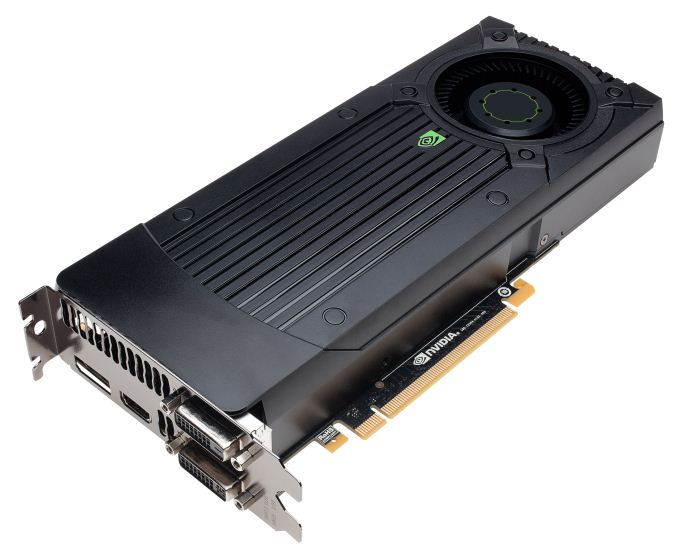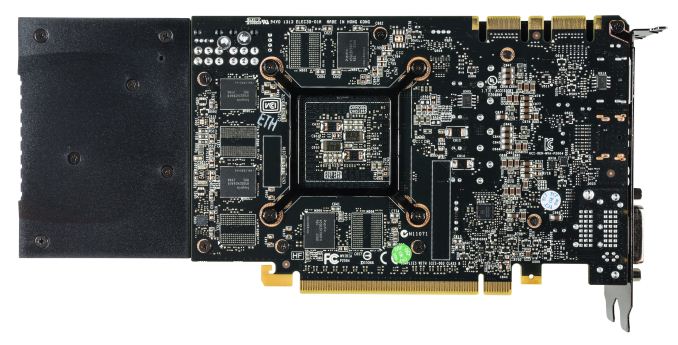NVIDIA GeForce GTX 760 Review: The New Enthusiast Kepler
by Ryan Smith on June 25, 2013 9:00 AM ESTMeet the GeForce GTX 760
As we mentioned earlier, due to its 170W TDP the GTX 760 is essentially a drop-in replacement for the GTX 670 in board designs. Even NVIDIA’s reference design reflects this, with the reference GTX 760 being based on the reference GTX 670’s cooler and PCB. Consequently there’s not much to say about the GTX 760’s design that we haven’t said before. If you’ve seen a GTX 670 then you’ve seen a GTX 760, down to the last screw. For consistency we’ll quickly go over the GTX 760’s design, but this is generally a rehash of what we’ve already said about the GTX 670.
Like GTX 670 before it, GTX 760 is another “small” GK104 design. The complete card is 9.5” long, however the actual PCB is far shorter at only 6.75” long, 3.75” shorter than the GTX 770’s PCB. In fact it would be fair to say that rather than strapping a cooler onto a card, NVIDIA strapped a card onto a cooler. Meanwhile we see that once again NVIDIA is using Hynix R0C (6GHz) GDDR5 RAM here.
The cooler itself is fairly simple, utilizing an aluminum heatsink melded with a copper base plate. A separate heatsink covers the VRM circuitry – once again mounted at the front of the card – while the fan hangs off of the rear of the card. This unfortunately is the same fan as on the GTX 670, which means it makes a faint grinding sound at low RPMs. This design has proven more than adequate for the GTX 670s, though it does leave some room for NVIDIA’s partners to improve on overall cooling performance, especially with open air coolers.
Elsewhere at the top of the card we’ll find the PCIe power sockets and SLI connectors. Two 6-pin PCIe sockets provide the necessary external power, while a pair of SLI bridge connectors at the other end allow for up to 3-way SLI. NVIDIA’s standard I/O configuration also makes an appearance here, offering 2x DL-DVI, 1x HDMI, 1x DisplayPort 1.2.
Looking at clockspeed bins for a moment, it comes as no great surprise that like the GTX 770, the GTX 760 operates at 1.2v at its highest stock clockspeed bin. The higher voltage versus the 1.76v limit on the 600 series causes power consumption to jump up more rapidly at the highest bins, but is necessary to unlock the 1100MHz+ clockspeeds the card is capable of.
| GeForce Clockspeed Bins | ||||
| Clockspeed | GTX 770 | GTX 760 | ||
| 1162MHz | N/A | 1.212v | ||
| 1149MHz | 1.212v | 1.2v | ||
| 1136MHz | 1.2v | 1.187v | ||
| 1123MHz | 1.187v | 1.162v | ||
| 1110MHz | 1.162v | 1.15v | ||
| 1097MHz | 1.15v | 1.137v | ||
| 1084MHz | 1.137v | 1.125v | ||
| 1071MHz | 1.125v | 1.112v | ||
| 1058MHz | 1.112v | 1.1v | ||
| 1045MHz | 1.1v | 1.087v | ||
Finaly, for overclockers there is one further bin (1162MHz) available via overvolting to 1.212v. The maximum power target meanwhile is 115%, for a final power limit of 195W.
















110 Comments
View All Comments
kennyG - Tuesday, June 25, 2013 - link
I for one was not happy with the out come of the 760 tested . I wanted Nvidia to totally take the 670 and enhance it and make a 760..Do the same process like they did with the 680 to 770. I really wanted to buy this card... Waiting for this one and I'm pisssed.Laststop311 - Tuesday, June 25, 2013 - link
I wonder how 2 of these(500) in sli compared to the GTX 780 single gpu (650)xTRICKYxx - Wednesday, June 26, 2013 - link
About Titan/GTX 690 levels.Ribozyme - Tuesday, June 25, 2013 - link
Ryan, could you please elaborate why the 760 draws considerably more power than a 670 while still being slower? Is this because a lower clocked 670 is compared to a pretty high clocked 760 in comparison? What would the situation be if you compared a 760 to a 670 clock per clock? And would I be able to power this with a be quiet straight power e9 400w + 3770k folding 24/7 ?And last question, are your power consumption values measured from the socket with a watt meter or with ampere meter on each cable and then added up?
Ryan Smith - Tuesday, June 25, 2013 - link
The biggest difference between the 760 and 670 is that the 760 has GPU Boost 2.0, which is a significantly different method of adjusting clockspeeds around temperature and power limits. The 670 had a TDP of 170W, but in practice its power target (a concept that doesn't exist with Boost 2.0) was below that. Whereas the GTX 760, if not constrained by temperatures, will get closer to its 170W TDP more frequently.The other difference is as you note: clockspeeds. The GTX 760 has fewer SMXes, but it operates at a higher clockspeed and with higher voltages (1.2v vs. 1.175v). That really eats up power at the highest boost bins. The 760 is essentially a little less wide and a little deeper than 670; clock for clock the 670 is going to be faster (but it won't be able to clock quite as high).
As for your PSU question, I'm afraid I can't answer that in any confidence. Based on specs I'd think that would work, but I don't know anything about that PSU.
Finally, power consumption is measured at the wall.
JimmiG - Wednesday, June 26, 2013 - link
Many non-reference GTX 670's boost higher, though. For example, my KFA² GTX 670 almost always boosts to 1,189 MHz, sometimes higher. If you can find a cheap, non-reference GTX 670 before they go out of stock, it might be a better deal.vision33r - Tuesday, June 25, 2013 - link
The last 3 years we saw really no innovation in the desktop GPU market. If you bought a HD 5870, you can still rock that card today in every game without any issue. We will see most of today's card get tossed when 4k monitors become a reality. Even SLI/CF top end cards today will score sub 30fps when games are played natively at 4k res.Kutark - Tuesday, June 25, 2013 - link
Ive been looking for the right price point to upgrade my GTX570, especially with BS4 coming out soon. I was hoping this would be it, but it looks like its really not enough of a jump to justify $250, especially when i could put that money towards a PS4 for some of the console games that wont be ported to PC. Any opinions otherwise?Kutark - Tuesday, June 25, 2013 - link
Haha, meant to say BF4, but yah, you get what i meant lol.mapesdhs - Tuesday, June 25, 2013 - link
:D That was a good one. :)
I suppose it depends on what you want from an upgrade. Are you looking for at
least a 2X speedup? If so then yes, atm you'd probably have to aim higher than
a 760. Indeed, I have a hunch that 570 SLI might match a 770 (that's an option I
suppose, get a 2nd used 570 for the interim).
Ian.